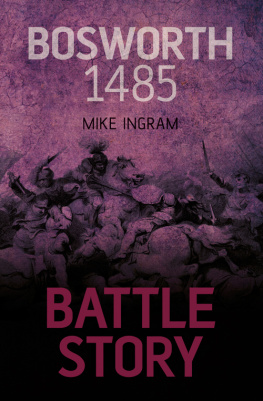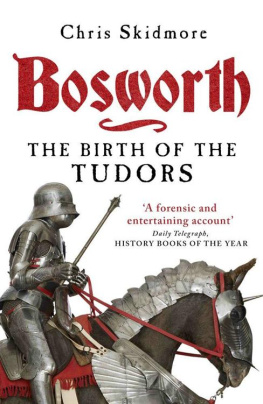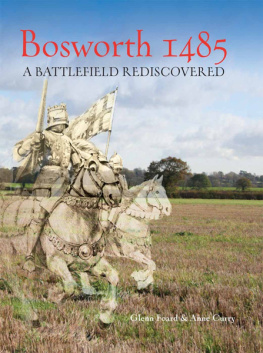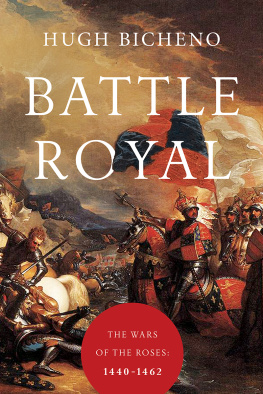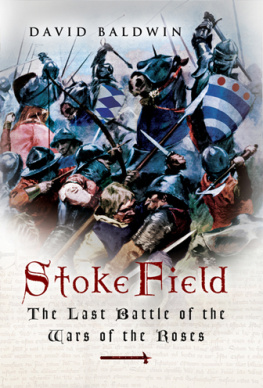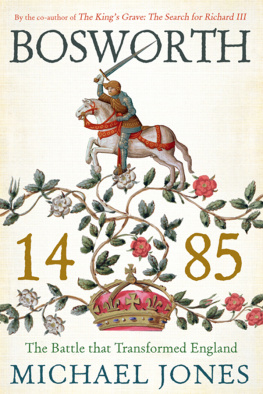
Firstly, I must thank Jo de Vries, series editor, for her suggestion that I should write this book in the first place and for her guidance.
Special thanks must go to Ian Post for his support over the years, his suggestions, and our many, often long discussions on how events unfolded in 1485. The same must go to Joe Ann Ricca of the Richard III Foundation for her interest in the project, her suggestions and support. I must also thank Toby McLeod for his words of wisdom, Richard Mackinder at the Bosworth Battlefield Centre, Allan Harley and the members of the Beaufort Household and Medieval Siege Society who helped with the practicalities of medieval warfare. I must also thank all those, too many to mention by name, who were involved in finding the actual site of the battle, and making this book possible.
The last words, however, must go to my children, Finley and Ellen this book is for you.
CONTENTS
A Family Divided
Descent into War
The War of Succession
The Destruction of the Nevilles and Lancaster
The Usurpation of the Throne
The Commanders
The Soldiers
Rebellion
The Storm Clouds Gather
Invasion
The Battlefield
Deployment
The Battle
Bosworth as a Tudor Victory
Bosworths Place in History
1. London from a fifteenth-century manuscript. (Authors collection)
2. One of the earliest published copies of Shakespeares play Richard III . (Authors collection)
3. Richard III. (Authors collection)
4. Henry VII. (Authors collection)
5. Thomas, Lord Stanley, Earl of Derby. (Authors collection)
6. Shooting arrows at the butt. (Authors collection)
7. Detail of the Battle of Grandson from the Luzerner-Schilling. (Authors collection)
8. The standard of John de Vere. (Freezywater Publications)
9. Henry Tudor standard. (Freezywater Publications)
10. Richard III standard. (Freezywater Publications)
11. Thomas, Lord Stanleys standard. (Freezywater Publications)
12. Trumpets were often used to communicate commands. (Authors collection)
13. Sir William Stanleys banner. (Freezywater Publications)
14. Rhys ap Thomas banner. (Freezywater Publications)
15. Thomas, Lord Stanleys banner. (Freezywater Publications)
16. A modern reconstruction of Milanese armour with a barbute helmet. (Authors collection)
17. Gothic-style breastplate. (Authors collection)
18. One of the few surviving examples of English-style armour. (Armour Services Historical)
19. The Trevanion Sallet. (Armour Services Historical)
20. Gothic armour. (Authors collection)
21. Two views of an Italian armet showing how it opened. (Authors collection)
22. Brigandine . Maison Tavel, from an original in Geneva. (Armour Services Historical)
23. Arm protection. (Authors collection)
24. Gothic-style gauntlets. (Authors collection)
25. Inside a medieval flak jacket called the brigandine, made from small plates rivited to fabric. (Armour Services Historical)
26. Mounted man at arms in composite Gothic armour with an equally well-protected horse. (Authors collection)
27. The wounded man. A contemporary illustration showing the ways a man could be wounded in battle. (Authors collection)
28. Reproduction medieval arrow heads. (Authors collection)
29. An English archer. (Authors collection)
30. Fifteenth-century halberds. (Authors collection)
31. Pollaxe. The weapon of choice for the man at arms. (Authors collection)
32. Crossbowmen and their protective shield called a pavise from a contemporary manuscript. (Authors collection)
33. Re-enactors portraying the French infantry at Bosworth; note the 16ft longspears, more commonly known today as pikes. (Authors collection)
34. Early bronze cannon mounted on a wheeled carriage from a contemporary manuscript. (Authors collection)
35. Fifteenth-century hand-gunner. (Authors collection)
36. The type of cannon known as a hackbut on a wooden frame from a contemporary manuscript. (Authors collection)
37. A single-edged sword known as a hanger and a small metal shield called a buckler. (Authors collection)
38. John Howard, Duke of Norfolk. (Authors collection)
39. Sutton Cheney church. (Richard III Foundation inc.)
40. Looking towards the area on the battlefield where the boar was found. (Ian Post)
41. Looking west across Henrys position. (Ian Post)
42. Looking east across the battlefield towards Stoke Golding and Crown Hill. (Ian Post)
43. Looking west across the battlefield, where Richard was initially deployed. (Ian Post)
44. One of the lead cannonballs in situ on the battlefield. (Authors collection)
45. A modern reconstruction of a fifteenth-century cannon. (Authors collection)
46. The battle started with an archery duel. (Authors collection)
47. After the archery duel, Richards army charged and vicious hand-to-hand fighting followed. (Authors collection)
48. Richard had a contingent of hand-gunners, possibly from Burgundy, in his army. (Authors collection)
49. The last charge of the Plantagenets. (Authors collection)
50. Victorian engraving of Henry being given the crown by Thomas, Lord Stanley. (Authors collection)
51. Richard IIIs badge and motto in stained glass at York Minster. (Authors collection)
52. Richards livery badge. (Authors collection)
Maps
Initial movements
First phase
Second phase
Third phase
Fourth phase
Fifth phase
A horse! A horse! My kingdom for a horse!
William Shakespeare, Richard III , Act V, Scene VII
These are the famous last words of Richard III at the Battle of Bosworth, at least according to William Shakespeare. Shakespeares version of events and the image that the last Plantagenet King of England was a misshapen antichrist have always clouded the truth of Richard IIIs life. Since then, there have been many tomes written by both the supporters and detractors of Richard III; of the mysterious death of the Princes in the Tower; and of the usurpation of the throne itself. Indeed, scholars and historians will no doubt continue to debate Richards character and life for many years to come.
This book, however, is not about a king, but about one of, if not the, most important battle in English history after the Battle of Hastings in 1066. The Battle of Bosworth (or Redemoor) was fought on 22 August 1485 and was the penultimate battle of the Wars of the Roses, a series of dynastic civil wars fought for the throne of England. It is often regarded as the end of the Middle Ages and the beginning of the Renaissance, although in reality the change was much more gradual. Nevertheless, it does mark the beginning of the reign of the Tudors, with Henry VII taking the throne at the end of this fateful day, before his son Henry VIII and his granddaughter Elizabeth I would go on to lead the country to previously unknown greatness.
Considering its importance, very little was written about the battle either at the time or during Henrys reign. Not only that, but most accounts were written by people with either little or no concern for military tactics, making any reconstruction of the battle difficult. It would be another 160 years and another important battle in English history, Naseby, before the tactics and dispositions of the troops would be recorded in any detail. It is also an old adage that history is written by the victor, but in the medieval period it usually was, and as such was heavily biased.
Of all the accounts, the Crowland Chronicle is probably the most contemporary. It was commissioned by the Benedictine Abbey of Crowland (or Croyland) in Lincolnshire and was written in two parts known as the First and Second Continuations. The Second Continuation, which details the battle and the events leading up to it, was probably written the year after the event. Its author was most likely John Russell, Bishop of Lincoln, who was keeper of the privy seal for Edward IV and chancellor under Richard III. He probably accompanied Richard III on the campaign and as such was well informed. However, he was not an eyewitness to the battle and does little to disguise his dislike of Richards rule.
Next page
